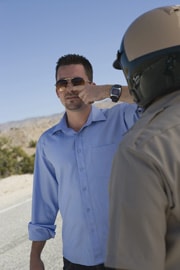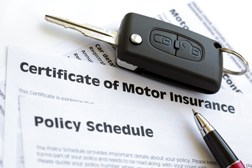Just about everyone is familiar with basics of field sobriety testing. Did you know the sometimes controversial tests are actually standardized and graded? Failing the tests can be grounds for a DUI arrest in some jurisdictions.
The Standardized Field Sobriety Test (SFST) is a battery of three tests administered and evaluated in a standardized manner to obtain accurate indicators of impairment and establish probable cause for arrest. These tests were developed as a result of research sponsored by the National Highway Traffic Safety Administration (NHTSA) and conducted by the Southern California Research Institute.
A training program was developed to aid law enforcement officers to become more skillful at detecting DUI offenders, describing the behavior of the drivers, and presenting effective testimony in court. Formal administration and accreditation of the program is provided through the International Association of Chiefs of Police. In some states only the three tests of the SFST are allowed to be admitted to evidence in a DUI / DWI trial.
The three tests of the SFST are:
- Horizontal Gaze Nystagmus Test (HGN)
- Walk-and-Turn (WAT)
- One-Leg Stand (OLS)
These tests are considered divided attention tests and test a driver’s ability to perform mental and physical multitasking that is required to operate a motor vehicle. These tests are administered and evaluated according to measured responses of the driver.
HGN Test
 Horizontal Gaze Nystagmus (HGN) is an involuntary jerking of the eye that occurs naturally as the eyes gaze from side to side. When sober HGN occurs when the eyes are rotated at high peripheral angles. However, when a person is impaired by alcohol, HGN is exaggerated. An alcohol-impaired person might also have difficulty smoothly tracking a moving object. In the HGN test, the officer observes the eyes of a person as he or she follows a slowly moving object such as a pen, horizontally with his or her eyes. The officer looks for three signs of impairment in each eye:
Horizontal Gaze Nystagmus (HGN) is an involuntary jerking of the eye that occurs naturally as the eyes gaze from side to side. When sober HGN occurs when the eyes are rotated at high peripheral angles. However, when a person is impaired by alcohol, HGN is exaggerated. An alcohol-impaired person might also have difficulty smoothly tracking a moving object. In the HGN test, the officer observes the eyes of a person as he or she follows a slowly moving object such as a pen, horizontally with his or her eyes. The officer looks for three signs of impairment in each eye:
- if the eye cannot follow a moving object smoothly,
- if jerking is distinct when the eye is at maximum deviation, and
- if the angle of onset of jerking is within 45 degrees of center.
If, between the two eyes, four or more clues appear, the suspect likely has a BAC of 0.08 or greater. NHTSA research has found this test allows proper classification of approximately 88 percent of testers.
Walk and Turn
The Walk-and-Turn test and One-Leg Stand test require a person to listen and follow instructions while performing simple physical movements. Intoxicated people have difficulty with tasks requiring their attention to be divided between mental and physical exercises.
In the Walk-and-Turn test, the tester is directed to take nine steps, heel-to-toe, along a straight line. After taking the steps, the suspect must turn on one foot and return in the same manner in the opposite direction. The officer then looks for the below eight signs of intoxication.
- Cannot keep balance while listening to the instructions
- Begins before the instructions are finished
- Stops while walking to regain balance
- Does not touch heel-to-toe
- Steps off the line
- Uses arms to balance
- Makes an improper turn
- Takes an incorrect number of steps
NHTSA research shows 79 percent of people who exhibit two or more indicators during the test will have a BAC of 0.08 or greater.
One Leg Stand
In the One-Leg Stand test, the suspect is instructed to stand with one foot about six inches off the ground and count aloud by thousands until told to put the foot down. The officer times the subject for 30 seconds. The officer is looking for the below four signs of impairment:
- swaying while balancing
- using arms to balance
- hopping to maintain balance
- putting the foot down
NHTSA research shows 83 percent of people who exhibit two or more signs during the test will have a BAC of 0.08 of greater.
Combined Measures
When the component tests of the SFST battery are combined, officers are accurate in an astonishing 91 percent of cases!
For more information about field sobriety tests, contact an attorney in your state.


Leave a Reply
You must be logged in to post a comment.